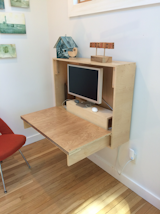Collection by Allie Weiss
How to Build a Compact, Fold-Down Desk for Small Spaces
In our September issue, we covered a tiny outbuilding for a family in Gloucester, Massachusetts. Residents Tim and Meg Ferguson Sauder and their three kids built the 168-square-foot space themselves using reclaimed materials. On their blog, Crafted Fairly, they post information about the products and custom furniture that outfit the space. Here, we share a snippet from the site about how they built the custom desk featured in our pages.
"We used a couple of piano hinges to allow for the fold-down action," Tim says. "They give you nice clean lines and are really strong. This was important because in researching fold-down desks we found that many of the options available out there look beautiful but are actually pretty rickety when you sit down and really use them like a real desk."
"We laid out the desk in Illustrator before cutting anything to gauge size and to make sure we could fit all the pieces most efficiently onto a sheet of plywood. We were doing this on the cheap, so we just worked with Birch plywood and hardware from Home Depot but did drop a little bit of money on nice magnets from Rockler."




